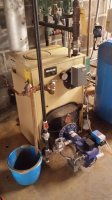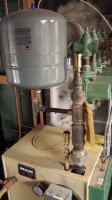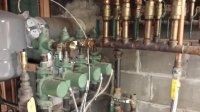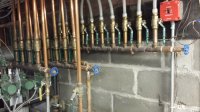The system pressure is fine.
To get maximal benefit out of the thermal mass in the system, increase the differential to it's maximum setting.
Then it's a matter of testing how low you can set the temp without it dropping below 130F on any part of the burn cycle, and without short-cycling. The high-limit needs to be at least 15-20F above the setting on the indirect though, which may involve incrementally turning down the indirect as the high-limit get's bumped down.
It's worth testing the minimum burn time during a continuous call for heat from your smallest zone (measured by the amount of radiation, not square feet of floor area.) Do do this, temporarily turn the temp down on the indirect and turn the thermostat for the other zone down (or off), then raise the thermostat setting on the "small" zone up by 6-8F, and observe the behavior of the boiler, during that extended call for heat. In a perfect world it would always run at least 10 minutes/burn or longer, but a 5 minute burn time is not an efficiency disaster. Burn times of 3 minutes or less, and 10+ burns/ hour is getting into short-cycling territory deep enough to matter. Maximizing the differential setting will lengthen the burns, as will raising the temperature.
If it's running choppy 1.5-2 minute burns every 5 minutes even at 180F with the differential set to 20F (or whatever it's maximum is), it's worth taking other measures, such as installing a heat-purging economizer (bypassing some of the aquastat controls) to deliver even higher differentials for longer burns, while decreasing standby losses despite higher peak temperatures, lowering the average system temp by purging boiler heat into the zone at both the beginning & end of calls for heat. The simpler versions are a $150-200 piece of hardware, and are DIY-able for those who are comfortable with electrical wiring. They typically deliver ~10-15% fuel savings with boilers on the edge of short-cycling, even more for grossly oversized boilers that always short cycle, but next to nothing with systems that deliver minimum burn times above 5 minutes even on the smallest zone.




